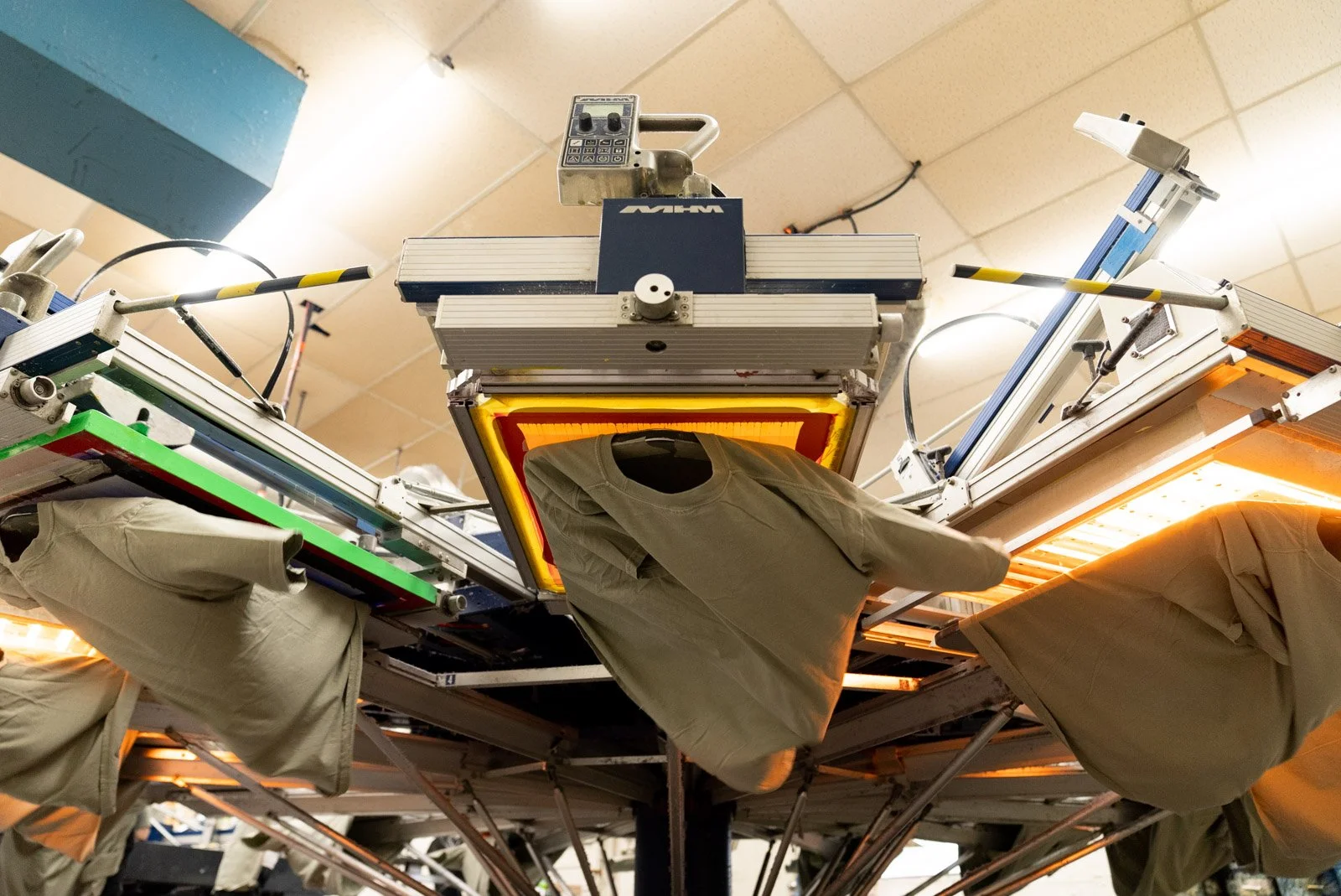Blue Ridge Graphics: A Sustainable Apparel Screen Printer
Blue Ridge Graphics is your full-service shop for everything branded, including screen printing, embroidery, and promo products. BRG is a family-owned and operated business in Charlottesville, VA. Founded in 1979 by John and Ruth Kulick and born out of a passion for t-shirt printing.
BRG is now certified by The Sustainable Green Printing Partnership (SGP), a non-profit organization for meeting sustainable environmental standards. SGP-certified printers are held to rigorous practices and go through a long vetting process where each aspect of the business is evaluated. SGP certification also verifies that BRG is focused on continuous improvement.
So far, BRG is the ONLY apparel screen printer in the United States to hold this certification and has been focused on sustainable, environmentally friendly business practices for many years.
Lisa Craig is the Chief Marketing Officer at Blue Ridge Graphics.
Hi Lisa, we’re excited to learn more about you and BRG. How did you start working there?
My background has been in health care and education. I was a customer of Blue Ridge Graphics, and I was working on a project with the owners of Blue Ridge graphics, and jokingly I said, “I'll just come work for you guys” and we laughed. Then a couple months later, I got a phone call from one of the owners asking me to work for them. I’d been a customer of theirs for well over a decade before I became an employee.
What do you love about working with this company?
I've always secretly been a t-shirt junkie. I know it sounds silly, but t-shirts really do bring people together. It's this idea of camaraderie, shared purpose, shared values, and nostalgia. When you have your favorite t-shirt on, you know where it came from, why you have it, if it was part of an event, or if it was something symbolic.
T-shirts are something I've always tried to do in any marketing program I've ever run, especially in education. Children and adults have an attachment to that specific article of clothing. T-shirts have just always been something that's super fundamental in the marketing space.
Funnily enough, statistics agree with me because t-shirts are still the number one promotional marketing giveaway. They top all other forms of traditional marketing because people love them, they wear them, and it's consistent brand awareness for years and years to come.
Are t-shirts your core business?
Our business started as a t-shirt printer when it was founded in the 70s. We can trace screen printing back for centuries, but it became part of the pop culture movement in the 60s, and it started taking off in the 70s. Screen printing is truly an art form. We've added a lot of other decorating techniques over the years, but the heart of the business is still very much screen printing.
Are there other methods of printing on t-shirts today?
There are many ways to print a t-shirt these days. A lot of other decorators do direct-to-garment. An easy way to describe a direct-to-garment printer is like loading a t-shirt into an inkjet printer. If you were a child in the 80s, you probably remember heat press transfers. Transfers are still very much alive and well, and they’re an economical way to get a large variety of colors onto a garment.
But screen printing seems like the best method.
Yes! Screenprinting, for all intents and purposes, will outlast your garment! It’s a high-quality art form that will stand the test of time.
What kind of ink is used?
Traditional ink for screen printing is called plastisol ink. In recent years water based ink has also become available, which has a much softer, lighter feel. The newest type of ink is called algae ink, and it’s actually made out of algae. There aren't any colors for algae ink, it’s just black, and because it’s made from a natural resource, it's actually considered what they call a “living ink.” Anytime you can use that for printing, you know it's the absolute most sustainable option.
Shirt printed with algae ink
Great segue to talk about sustainability. I came across Blue Ridge graphics through my search in the Sustainable Green Printing Partnership (SGP) database.
We’re the only apparel screen printer in the country certified as a Sustainable Green Printer. We wanted to do that particular certification because it provided us with third-party validation for our sustainability efforts. So it wasn't like we just woke up one morning and decided we should do this and change our entire business model. These were things that were already ingrained into our processes and our practices. So for us, it just made sense.
When companies use words like being “green” or being “sustainable” they just become vocabulary words that don’t mean anything. We wanted something that pushed us to always look for ways to improve ourselves, to improve processes, to improve our systems, and reduce waste. All the things you say you're going to do, but now you're going to do them, and then you're going to show the proof of how you're doing it, and why you're doing it.
Third party verification is so important. It stands out when I'm looking for sustainable vendors. You know that a company has taken the time and effort, and even spent money to be more sustainable.
Being SGP certified has always been a milestone goal. The owners started pre-COVID, and it got put on the backburner with everything else happening in the world. When I came onboard, I wanted to push this over the finish line.
Initially, we had to get all of the paperwork together. They have something called an “impact tracker” and things we were already doing with our processes and procedures get funneled and documented into what SGP calls a “sustainability management system” for the SGP auditors.
We also started an SGP Committee, taking people from different areas of our business and coming together as a group to talk about where we are in the business, what's working, what's not working, and then coming together to form opportunities for continuous improvement projects year over year.
This will be our second year as an SGP-certified printer. Last year was an overall commitment to waste reduction and documenting waste, reuse, and recycling. And while we were doing all of those things, we also started tracking the volume of what that actually looked like.
I’m so glad you brought up the SGP Committee. I’ve found that companies with successful sustainability programs have this in common, that they started a “Green Team.” (Here’s an article about how and why to start a Green Team).
Yes, it's everybody listening to everybody.
What are some of the things that make your screen printing business sustainable?
We've already talked about the use of water-based inks, which is not unique to us by any means. But we have our own solar energy rooftop grid. We also have a bioremediation system for washing the squeegees and screens. We’ve made sure our bioremediation system is as clean and as efficient as possible. After each job, we use a post-production filtration system to keep the water as clean as it possibly can be.
Bioremediation sink
And what about the t-shirts themselves?
We work with clients to source the look and type of garment that they want, and there are a ton of options, from organic materials to recycled materials. The great thing about the garment industry is the sky's the limit in terms of what we can offer our clients these days.
Where are your clients based?
Literally everywhere. And if you ever buy t-shirts from us, you're not going to get your package a lovely custom box. We reuse every box if it is good and seaworthy. And it's gonna get a paper label on it that says that this is not my first time out in the world. This is one way we show our commitment. You might get a box that looks less than professional, but it is 100% one of the most earth-friendly things we can do.
Aside from t-shirts, what else can you print on?
The fun thing about screen printing is we can print on so many different things: tote bags, sweatshirts, long-sleeve tees, and any kind of apparel like sweats, shorts, you name it. If you can wear it, if you can put it on your body, we will figure out how to print it.
Blue Ridge Graphics: www.brgtshirts.com
Sustainability at Blue Ridge Graphics: www.brgtshirts.com
Connect with Lisa Craig on LinkedIn: www.linkedin.com/in/lcraig
Learn more about the Green Printing Partnership at www.sgppartnership.org.









